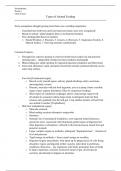Invertebrates
Week 2
Chris Foster
Types of Animal Feeding
Early assumptions thought grazing food chain was overriding importance
- Classified into herbivore/carnivore/omnivore [many more now recognized]
- Based on animal / plant kingdom [leaves out bacterial feeders]
- Now distinguished based on method.
1. Hunter/Predator, 2. Parasites, 3. Grazers, 4. Browsers, 5. Suspension Feeders, 6.
Deposit feeders, 7. Deriving nutrients symbiotically
Common Features;
1. Through-Gut; anterior opening to exterior [mouth food is taken in] and posterior
opening [anus – indigestible residue/excretory products discharged]
2. Blind-ending gut; single opening for ingestion/egestion [cnidarians and flatworms]
3. Some lack alimentary canal, absorption food from internal symbionts/directly across
outer body surface.
- Fore-Gut [Ectodermal origin]
o Buccal cavity [mouth opens, salivary glands discharge sticky secretions,
anticoagulants, toxins]
o Pharynx; muscular with aid food ingestion, acts as a pump, forms eversible
organ of prey capture [chordates; filter for suspension feeding]
o Short region of conduction esophagus and/or crop [storage organ] well
developed in consumers taking large meals at infrequent intervals then
releases only gradually into the mid-gut. Crop enables transfer of food from
one animal to another [Trophallaxis]
- Mid-Gut; [endodermal origin]
o Muscular stomach
o Blind ending secretory/absorptive outgrowths
o Intestines
o Stomach site of mechanical breakdown, sorts ingested material [possess
gizzard in some, concerned with trituration] partial region of digestion but
often digestion or absorption / effected in diverticula [caeca] issued from gut
posterior stomach
o Large, complex organs in mollusks, arthropods “hepatopancreas” – function of
liver and pancreas
o “lipid storage in mollusks // heavy metal storage in woodlice.
o Digestion largely intracellular, food taken up by phagocytosis of cells lining
absorptive region and digested within vacuoles. [prevalent in poriferans,
cnidarians, flatworms – any organisms with finely particulate form of food]
o In larger organisms, enzymes secreted in lumen of gut, diverticula are
secretory and absorptive happens in intestines.
, Invertebrates
Week 2
Chris Foster
- Hind-Gut; [Ectoderm origin]
o Formed by rectum, water absorption and fecal pellets formed prior to
discharge.
o Animals require energy-yielding compounds for immediate/later use from
food [amino acids for synthesis, vitamins as catalysts in metabolic reactions]
o Animals with diet low in protein or vitamin require symbiotic gut bacteria for
synthesis of the compound or ingest complex carbs [need bacteria to ferment
it]
1. Hunter and Parasites;
o Hunter; mobile animal with attack, kill and consume individual items one at a
time [usually other mobile organisms]
a. Pursuit hunter; chase, catch and subdue mobile prey
b. Searchers; active foraging and seeking out prey items with less
developed movement
c. Ambushers; relatively sedentary apart from fatal spring/dart.
o Weaponry; pursuers/ambushers have weapons to catch and immobilize prey
[organ surrounding the mouth- chelate/subchelate appendages in arthropods]
o Sucker/Hook; bearing arms [cephalopods]
o Spines in jaw organ of chaetognaths or powerful jaws associated with anterior
gut in annelids mounted in an eversible pharyngeal region with forcible and
rapidly shot out to catch prey.
2. Mimicry in Ambushers;
o Some use to attract prey, siphonophores possess tentacles bearing copepod
mimics; prey on copepod feeders [other crustaceans]
o Once caught, prey ingested whole, torn apart by appendages and consume
piecemeal, body fluid sucked out. If whole, anterior region of gut capable of
distended to accommodate meal.
3. Searchers;
o Feed on relatively sedentary prey, protect from attack by external covering of
CaCO3, cellulose, chitin
o Bore through protective casings [radula in mollusks] leaving hole, make
archeological interpretation hard.
o Prize apart elements of casing sufficiently to evert the stomach through the
gap, secrete enzymes and absorb products of extracorporeal digestion
o Swallow prey whole and crush shell in gizzard
o Suck out individual polyps and zooids from communal matrix by proboscis or
stylets and pharyngeal pump.
4. Suctorial Feeders and Parasites;
o Predatory insects and spiders suck fluid directly from prey or inject salivary
proteolytic enzymes to captured individuals [paralysis] to liquidity tissues
o Ectoparasitic lifestyle [feed but don’t kill] – depends on size
o Planktonic polychaetas attack, consume head end of arrow worms, prey
survives and regenerates head




